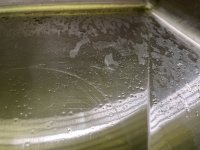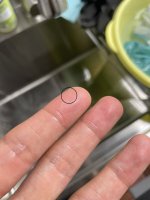Hi,
I had a chance to watch my softeners regeneration cycle.
What I see during the backwash cycle, I first saw a very cloudy water out from the drain and that was getting clearer when it approached to the end (10 min).
Next thing I found was that water drained during the backwash left very tiny particles in my mop sink. (My drain is out to a mop sink). At first, I thought it is a tiny bubble but it was particles and I can actually feel the grain with my finger. It is definitely not a resin I believe because the grain is as small as fine grain salt but the color was clear. Please refer the attached photos
I don't know much about how the regeneration supposed to look like so now I'm worrying if the softener has some problems.
Could you advice if these observations indicate some bad things going on my softener?
1. Cloudy water from drain at the beginning of backwash
2. Tiny clear particles left from backwashed water
Any advice is welcome.
FYI, my softener is fleck5800 2cuft tank and been using it for two month so far.
I had a chance to watch my softeners regeneration cycle.
What I see during the backwash cycle, I first saw a very cloudy water out from the drain and that was getting clearer when it approached to the end (10 min).
Next thing I found was that water drained during the backwash left very tiny particles in my mop sink. (My drain is out to a mop sink). At first, I thought it is a tiny bubble but it was particles and I can actually feel the grain with my finger. It is definitely not a resin I believe because the grain is as small as fine grain salt but the color was clear. Please refer the attached photos
I don't know much about how the regeneration supposed to look like so now I'm worrying if the softener has some problems.
Could you advice if these observations indicate some bad things going on my softener?
1. Cloudy water from drain at the beginning of backwash
2. Tiny clear particles left from backwashed water
Any advice is welcome.
FYI, my softener is fleck5800 2cuft tank and been using it for two month so far.


